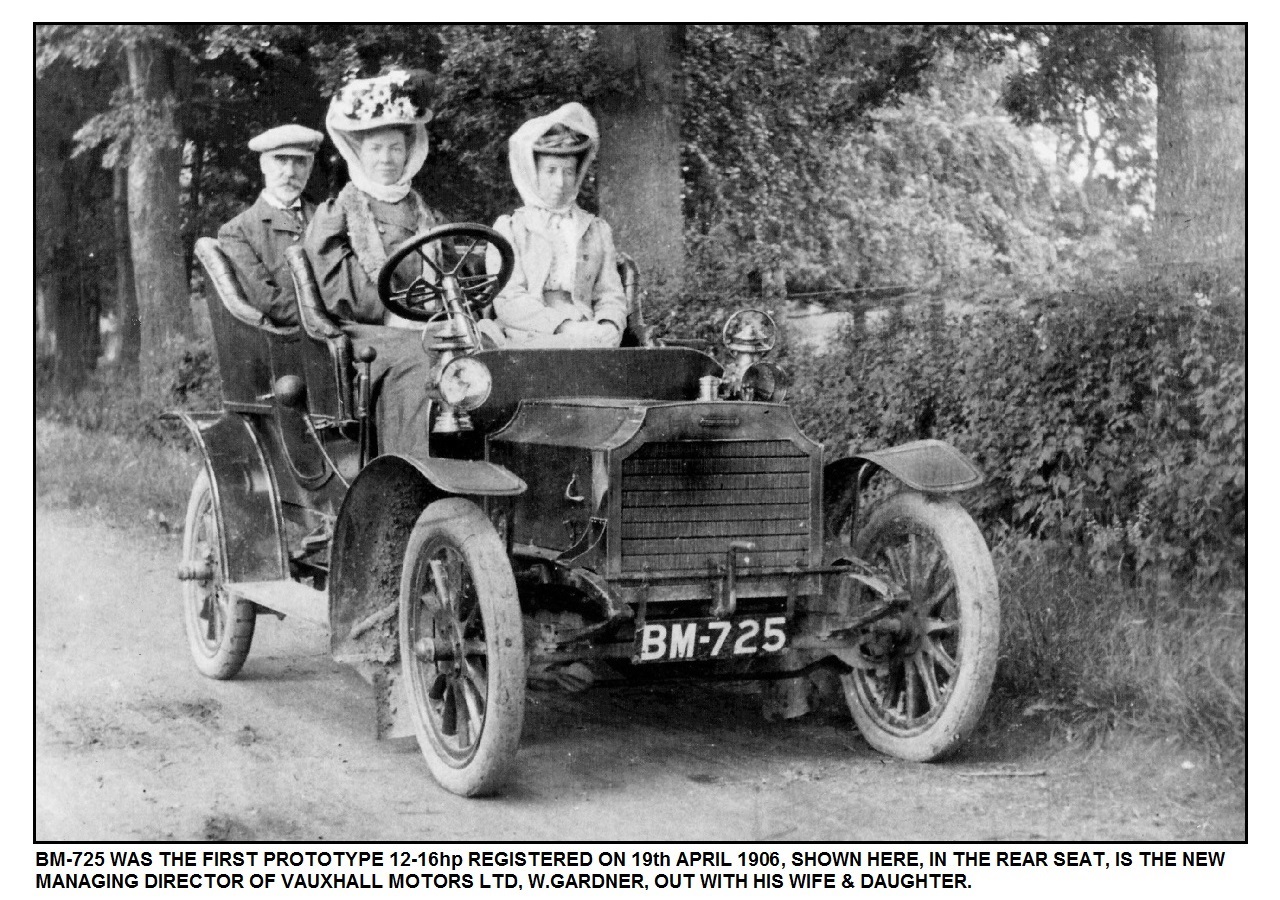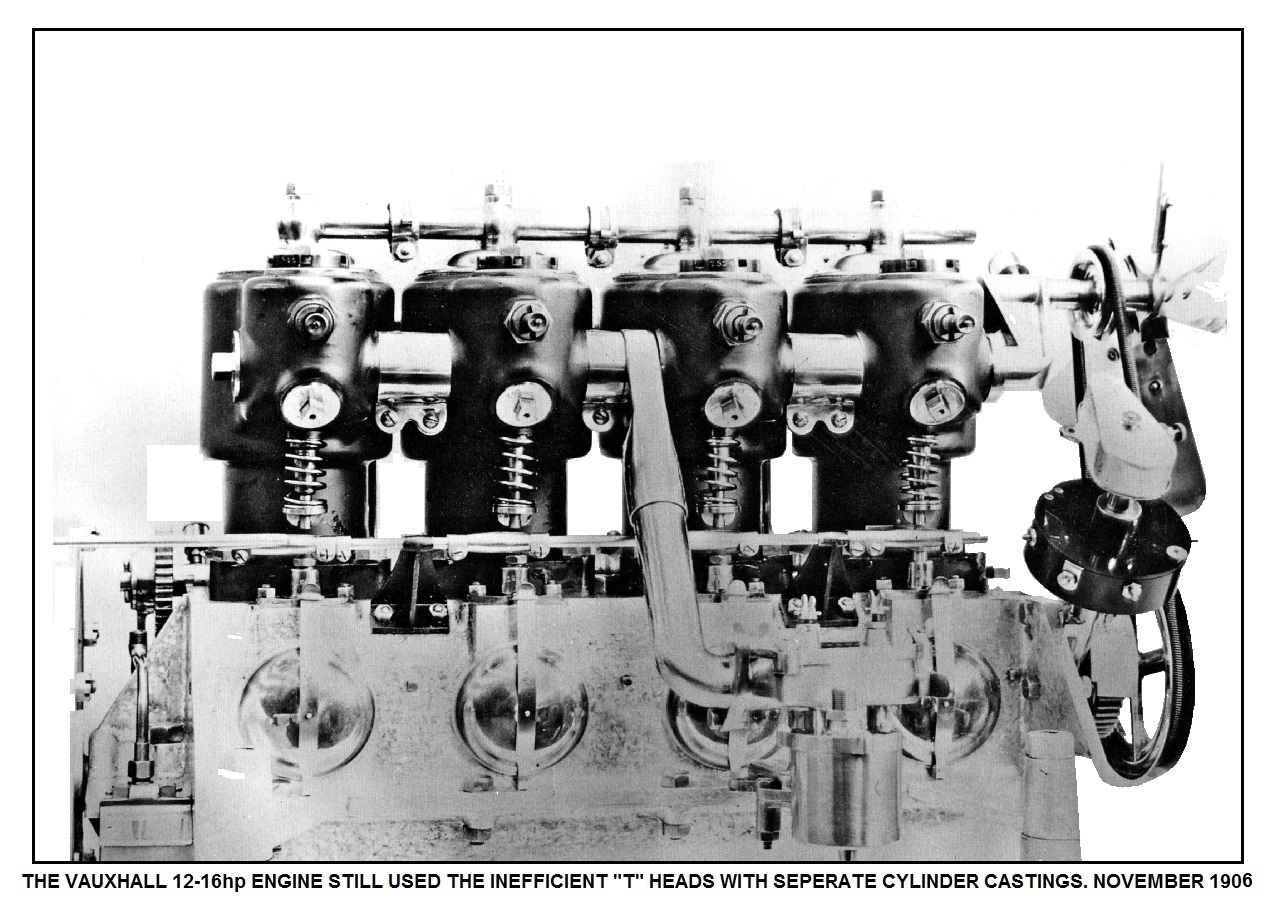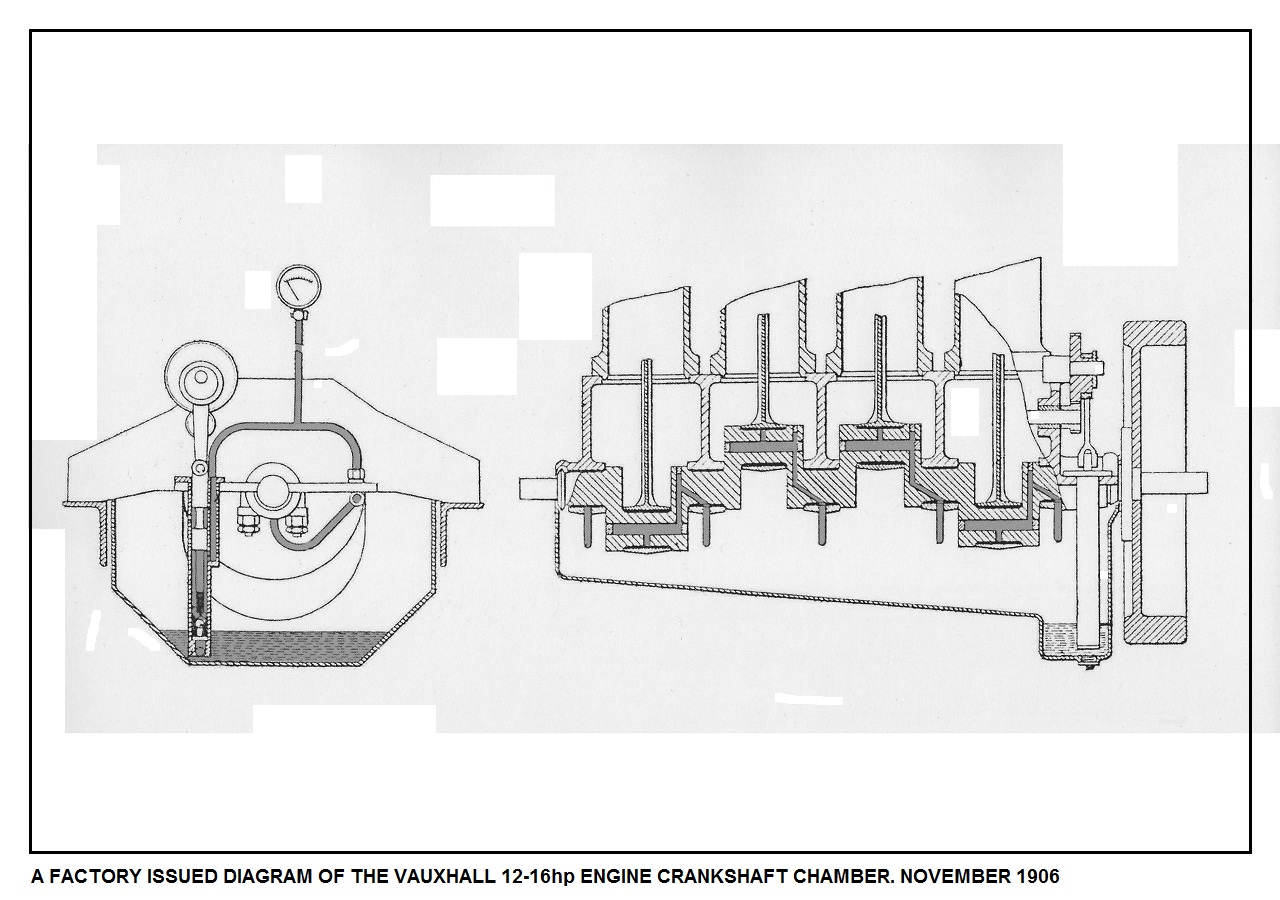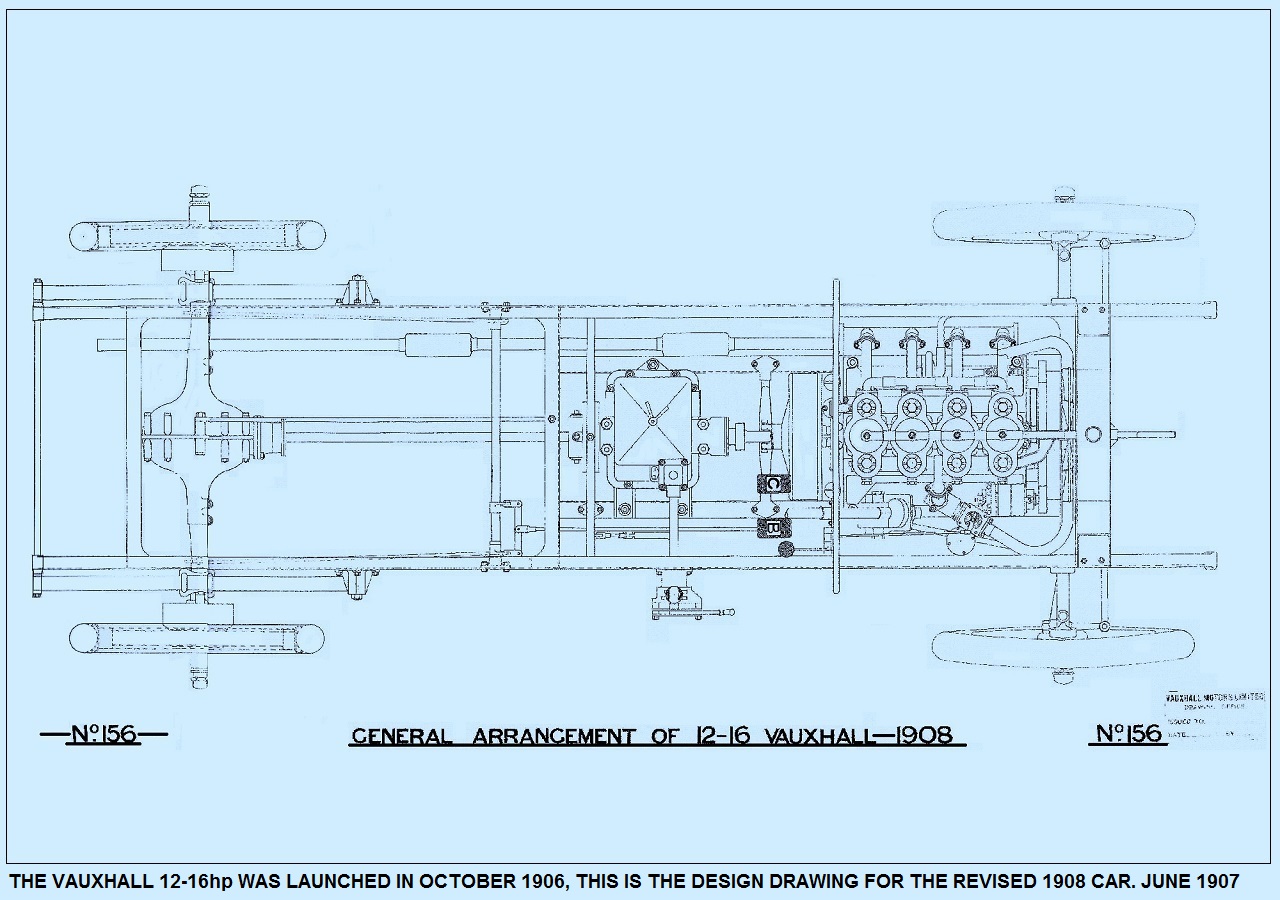

1. VAUXHALL 4-CYLINDER - 12-16hp
BACKROUND:
Since the very first Vauxhall motor car in 1903 the Company had developed the exterior design from the small and rather quaint looking “V” shaped bonnet style to a more orthodox & practical full width oblong engine cover using a distinctive upright radiator with concave fluting on either side. Bodywork had evolved, largely through outside coachbuilders, to become more elaborate and heavier but at the same time providing greater comfort and protection from the elements. In terms of engineering the lineage of all the Vauxhall engines could be traced back to the original single cylinder power unit of 1903 with additional cylinders added to eventually achieve a four cylinder engine, however this “cost effective” way of designing a suitable power unit had reached a point where some significant improvements would be required in order to continue to be competitive with rivals in areas such as power output vs engine weight, the means of mechanical component lubrication as well the drive system used to the rear wheels.
2. VAUXHALL 4-CYLINDER - 12-16hp DESIGN & ENGINEERING:

Design planning work had started on the new Vauxhall 12-16hp within months of the launch of the Vauxhall 18hp model with the first prototype registered on 19th April 1906 and was used & tested by the new joint Managing Director of Vauxhall Motors Ltd; W Gardner. The 12-16hp design was a significant improvement over the 18hp car in several key areas. The chain drive to the rear wheels was replaced by a drive shaft to a “live” rear axle, this shaft used a flexible joint between the rear axle & propeller shaft to allow movement of the shaft in relation to the chassis. The chassis itself was similar in design to the 18hp car with parallel sidemembers but the separate engine sub frame was extended backwards to include the gearbox mounting as well, this configuration helped protect the engine & gearbox alignment from chassis flexing which, despite valiant efforts, was still a problem. The twisting, or torque reaction, was controlled by control arm running from the rear axle casing to a drop link mounted on the chassis crossmember just behind the gearbox which was curiously now a three speed instead of four as fitted to the car’s 18hp predecessor, the rear straight bevel axle ratio was 4.1:1. The chassis dimensions were; 98ins wheelbase, later increased to 102ins, width 66ins and length 138ins.
Vauxhall offered their own standard 4 seat Touring body built in-house at Luton which enabled the car to be offered at a very competitive selling price of £375 complete. The car could also be ordered as a running chassis to be equipped with bespoke bodywork from outside coachbuilders. Vauxhall advertising at the time made great play on the fact the 12-16hp was their new “chainless” model. Made to order the 12-16hp was usually produced in batches of approximately a dozen at a time.

On paper there appeared to be a disappointing lack of development by F W Hodges of the engine compared to the 18hp model. The inefficient T-valve head design was the same and the primitive inlet valve wedge speed control was still retained. The engine had a bore and stroke of 3.5ins & 3.75ins giving a total capacity of 2366cc producing 23bhp @ 1800rpm and increased to 27bhp by the end of production. It was the lower half of the engine design which showed a quantum leap compared to previous models, the haphazard drip feed oil supply was instead replaced by a closed loop recirculating lubrication system that was pressurised by a pump driven from the back of the exhaust camshaft. Oil under pressure was fed to each main bearing and then on through a hollow crank brow to the adjacent big end journals. The crankshaft was supported by five generously sized bronze main bearings with a larger rear supporting the weight of the flywheel. The oil supply was drawn by the pump from a reservoir in the sump. The crankshaft was also drilled from the main bearings to the big end journals allowing these to be lubricated under pressure as well. Hodges had carefully managed to design a well-engineered lubrication system that laid the foundations of very impressive reliability for the 12-16hp and all Vauxhalls developed henceforth. These changes enabled the engine to use a higher compression ratio and an almost doubled maximum engine speed with no loss of reliability giving a top speed of just under 50mph with an average fuel consumption of 25mpg. Laurence Pomeroy had joined Vauxhall as Hodges assistant and it is likely that he had influenced some areas of the engine design but was never specifically credited for anything in particular.

The ignition system employed was originally by trembler coil with a high tension distributor, this was changed over to a magneto system during the middle of 1907. The White & Pope spray carburettor was a development of that used on the previous 18hp and patented by Vauxhall but with no butterfly it was still a rather crude design as the engine speed continued to be regulated by a hand controlled mechanical valve restriction, a floor mounted accelerator pedal was fitted from January 1907. The rear braking was unique at the time being fitted with external contracting drum brakes which were mechanically operated by a hand lever with a similar foot pedal brake operating on the transmission, although a novel idea before 12-16hp production ended internal expanding drum brakes were standardised.
Launched at the November 1906 Olympia Motor Show the Vauxhall 12-16hp sold reasonably well with a number of order taken at the exhibition still being delivered six months later. A total of 28 cars had been produced by the Summer of 1907 and once the last few 9hp cars were finished the 12-16hp became the only Vauxhall model in production. Production output was being hampered by the lack of space which had to be integrated with the marine, steam & pump business which was still a large part of the Vauxhall operation. The realisation that in order to make the motor car manufacture efficient as well as being commercially viable it would need to be separated from the heavy marine engineering side of the business and operate as a separate and re-financed stand-alone company. In April 1907 Percy Kidner and his trusted friend Leslie Walton formed a new company – Vauxhall Motors Ltd – as a means of acquiring the vehicle manufacturing side of The Vauxhall & West Hydraulic Engineering Company. Vauxhall Motors Ltd had an initial capital of £25,000 with the named Directors; Chairman - Leslie Walton with Percy Kidner & W Gardner as joint Managing Directors. Walton previously worked in merchant banking during which time he made many contacts in the banking & finance industry. In this respect he brought to Vauxhall considerable financial expertise and was able personally to contribute substantially to the capital requirements of the new company, he was also a keen motorist.
A new company structure was in place by the end of April 1907 and the heavy steam engine & pump manufacturing equipment was gradually moved from the original West Hydraulic Engineering premises located at the north end of the site thereby freeing up space that could now be used exclusively for more efficient motor car manufacture. F W Hodges was appointed Consulting Engineer and shortly after a young Laurence Pomeroy joined the company as his assistant. Vauxhall Motors Ltd now had a clear purpose and the Directors were united in the firm belief that competing in motor sport was a central part of their future plans. Unsurprisingly, within a matter of weeks Percy Kidner entered the Carters Hill climbing event where the 12-16hp proved reliable but too slow to gain a finishing place. Similarly, on 30th June 1907 Company Chairman Leslie Walton took part in the Southern Motor Club’s Speed Hillclimb with a 12-16hp, at the relocated event on Toys Hill near Sevenoaks in Kent. Despite a clean climb Walton only managed 3rd place having been completely outclassed by a Talbot 16hp car. Unlike earlier years, Percy Kidner had not entered in the Scottish Reliability Trial in 1906, however in June 1907 he entered the trial driving a 12-16hp registration number BM722 and despite only one involuntary stop to adjust an accelerator rod the car could only manage an 8th place out of 14 competitors in class III for vehicles costing between £300 to £400. Once again the lack of performance on the speed trial sections had let the car down in spite of exceptional reliability.

By November 1907 Vauxhall were offering the 12-16hp with various factory built bodies including a 4 Seat Tonneau, an open 2 Seat which was the cheapest at £360, a 4 Seat Landaulette or a running chassis for £330. The 1908 cars featured the first major changes to the 12-16hp specification. Engine size was enlarged by increasing the bore to 3 5/8ins giving a new capacity of 2537cc and a power output of 27bhp @ 1800rpm compared to 23bhp previously, the chassis was subject to detail design changes and a revised back axle was fitted. The first of these improved cars was delivered in April 1908 and were designated internally as the “X” Type 14-16hp but the 12-16hp moniker was retained in all publicity & advertising.
3. VAUXHALL 4-CYLINDER - 12-16hp PERIOD & PRESS PHOTOGRAPHS:

